Related Research Articles
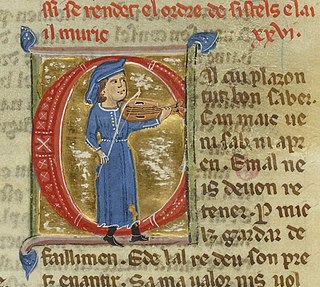
A troubadour was a composer and performer of Old Occitan lyric poetry during the High Middle Ages (1100–1350). Since the word troubadour is etymologically masculine, a female troubadour is usually called a trobairitz.

Aimeric or Aimery de Peguilhan, Peguillan, or Pégulhan was a troubadour born in Peguilhan, the son of a cloth merchant.

Marcabru is one of the earliest troubadours whose poems are known. There is no certain information about him; the two vidas attached to his poems tell different stories, and both are evidently built on hints in the poems; not on independent information.
A tenso is a style of troubadour song. It takes the form of a debate in which each voice defends a position; common topics relate to love or ethics. Usually, the tenso is written by two different poets, but several examples exist in which one of the parties is imaginary, including God, the poet's horse or his cloak. Closely related, and sometimes overlapping, genres include:

Peire d'Alvernhe or d'Alvernha was an Auvergnat troubadour with twenty-one or twenty-four surviving works. He composed in an "esoteric" and "formally complex" style known as the trobar clus. He stands out as the earliest troubadour mentioned by name in Dante's Divine Comedy.
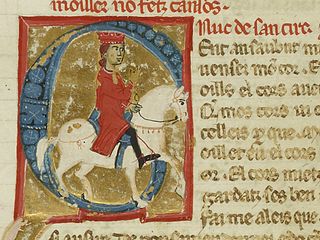
Uc de Saint Circ or Hugues (Hugh) de Saint Circq was a troubadour from Quercy. Uc is perhaps most significant to modern historians as the probable author of several vidas and razos of other troubadours, though only one of Bernart de Ventadorn exists under his name. Forty-four of his songs, including fifteen cansos and only three canso melodies, have survived, along with a didactic manual entitled Ensenhamen d'onor. According to William E. Burgwinkle, as "poet, biographer, literary historian, and mythographer, Uc must be accorded his rightful place as the 'inventor' (trobador) of 'troubadour poetry' and the idealogical trappings with which it came to be associated."
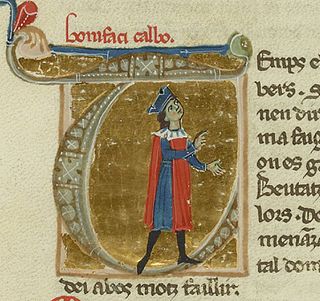
Bonifaci, Bonifatz, or Bonifacio Calvo was a Genoese troubadour of the late thirteenth century. The only biographical account of his life is found in the vida of Bertolome Zorzi. He is, however, the most notable Genoese troubadour after Lanfranc Cigala. In total, nineteen of his poems and two descorts have survived.

Gui d'Ussel, d'Ussèl, or d'Uisel was a turn-of-the-thirteenth-century troubadour of the Limousin. Twenty of his poems survive: eight cansos, two pastorelas, two coblas, and eight tensos, several with his relatives and including a partimen with Maria de Ventadorn. Four of his cansos melodies remain.

Daude, Deude, Daurde, or Daudé de Pradas was a troubadour from Prades-Salars in the Rouergue not far from Rodez. He lived to an old age and left behind seventeen to nineteen cansos, including twelve on courtly love, three about sexual conquest, one tenso, one planh, and a religious song. Only one melody of his entire oeuvre has survived.
Bertran d'Alamanon, also spelled de Lamanon or d'Alamano, was a Provençal knight and troubadour, and an official, diplomat, and ambassador of the court of the Count of Provence. Twenty-two of his works survive, mainly provocative tensos and sirventes, many dealing with Crusading themes.
Simon Doria was a Genoese statesman and man of letters, of the important Doria family. As a troubadour he wrote six surviving tensos, four with Lanfranc Cigala, one incomplete with Jacme Grils, and another with a certain Alberto. He was the son of a Perceval Doria, but not the Perceval Doria who was also a troubadour and probably his cousin.
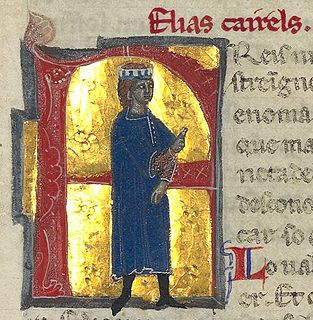
Elias Cairel was a troubadour of international fame. Born in Sarlat in the Périgord, he first travelled with the Fourth Crusade and settled down in the Kingdom of Thessalonica at the court of Boniface of Montferrat (1204–1208/10) before moving back to western Europe, where he sojourned at the court of Alfonso IX of León (1210–11) and in Lombardy (1219–1222/24). He wrote fourteen surviving lyrics: ten cansos, one tenso, one descort, one sirventes, and one Crusade song. He was partial to refrain rhyming and coblas capfinidas.

Bernart de Venzac was an obscure troubadour from Venzac near Rodez in the Rouergue. He wrote in the Marcabrunian style, leaving behind five moralising pieces and one religious alba. Two of his works were confused by copyists with those of Marcabru in some manuscripts.
Gavaudan was a troubadour and hired soldier at the courts of both Raymond V and Raymond VI of Toulouse and later on in Castile. He was from Gévaudan, as his name implies. He wrote moralising lyrics, either religious or political, and ten of his works survive, including five sirventes, two pastorelas, one canso, one planh for an anonymous domna (lady), and one Crusade song. He is sometimes clumped in a primitive Marcabrunian "school" of poetry alongside Bernart Marti, Bernart de Venzac, and Peire d'Alvernhe. He developed a hermetic style, combining elements of the trobar ric and trobar clus.
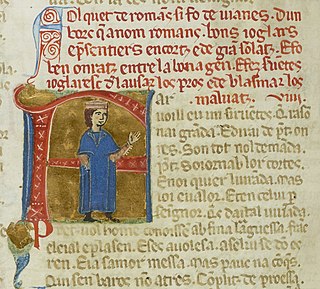
Falquetde Romans was the most famous troubadour attached to the court of Frederick II, Holy Roman Emperor, where he garnered a high reputation despite the fact that his career began as a jongleur. His surviving work consists of fourteen or fifteen pieces: seven sirventes, three tensos, two or three cansos on courtly love, a salut d'amor of 254 lines, and a religious alba. His poetry is, in general, clear and elegant, and he was apparently very religious.

Gui de Cavalhon, Cavaillo, or Gavaillo was a Provençal nobleman: a diplomat, warrior, and man of letters. He was probably also the Guionet who composed tensos and partimens with Cadenet, Raimbaut de Vaqueiras, Mainart Ros, Pomairol, and a certain Guillem.
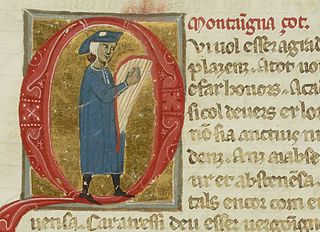
Guilhem de Montanhagol was a Provençal troubadour, most likely active in Toulouse, but known in the courts of Provence, Toulouse, Castile, and Aragon. Guilhem left behind seven cansos and six sirventes. He also left behind one tenso with Sordello and his total surviving output comes to fourteen pieces.
A gab or gap is a troubadour boasting song. It is often considered related to the tenso and partimen, two types of debate poem. Sometimes the gab is not considered a separate genre of poetry but simply a boast found within another genre, commonly the sirventes.
Aldric or Audric del Vilar was the twelfth-century lord of Auvillar and a troubadour. According to the vida of Marcabru, he raised the young Marcabru. This may in fact be derived by Marcabru's biographer from an exchange of satiric songs between the two, beginning with Audric's "Tot a estru" (16b.1), to which Marcabru responded with "Seigner n'Audric" (293.43). Audric may have been originally writing in response to Marcabru's gap "D'aisso lau Dieu". The whole exchange revolves around Marcabru's claim that he will accept bread from a fool so long as it lasts. On the other hand, both of Marcabru's pieces, which share Audric's metrical form, may be responses to Audric. Audric introduced the nickname Pan-Perdut (Breadless) for Marcabru.
Chardon de Croisilles or de Reims was an Old French trouvère and possibly an Occitan troubadour. He was probably from Croisilles, but perhaps Reims. He is associated with the school of trouvères in and around Arras. Chardon wrote four chansons d'amour, two jeux partis, and one partimen.
References
- Gaunt, Simon. Troubadours and Irony. Cambridge: Cambridge University Press, 1989. ISBN 0-521-35439-0.